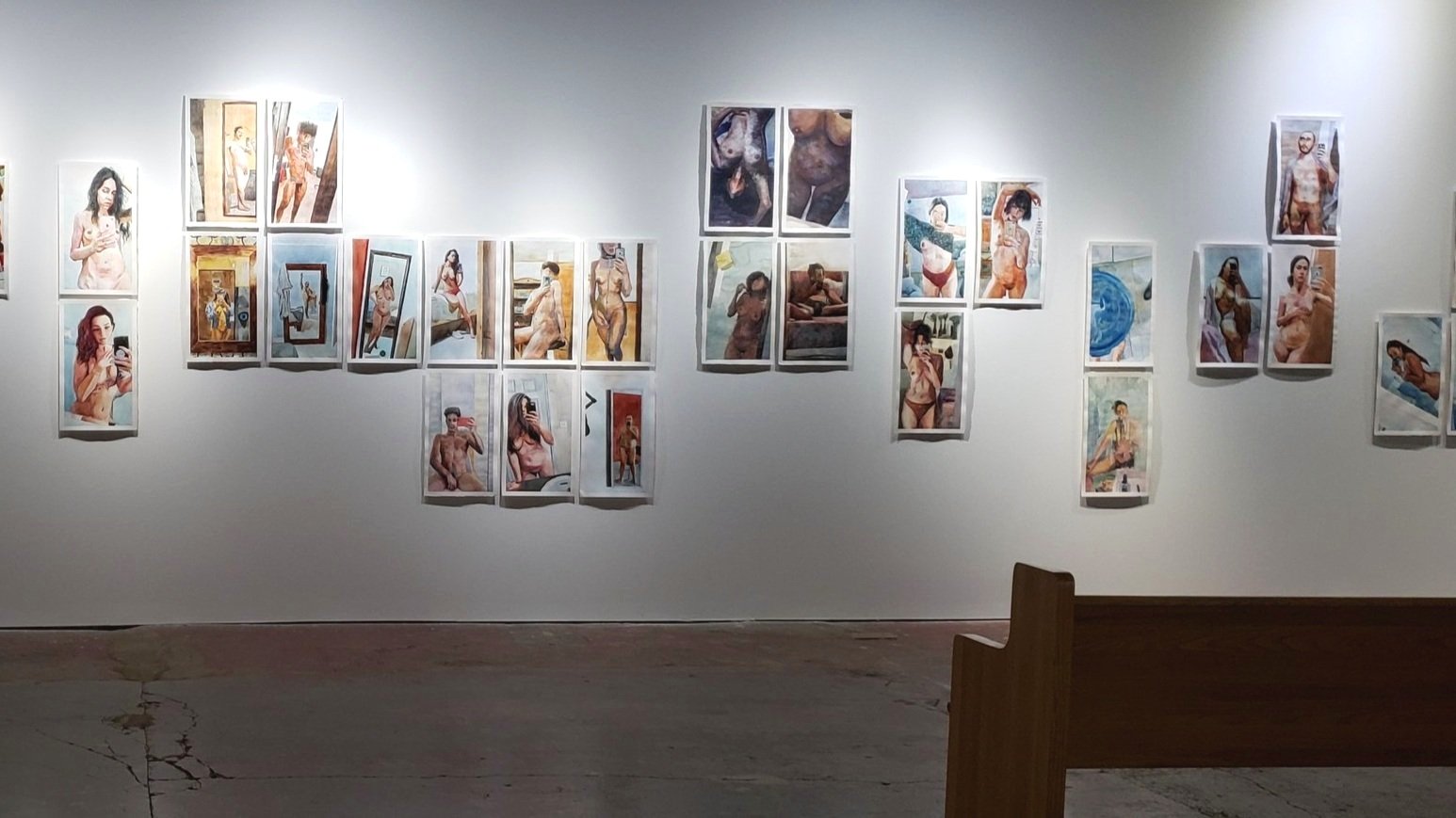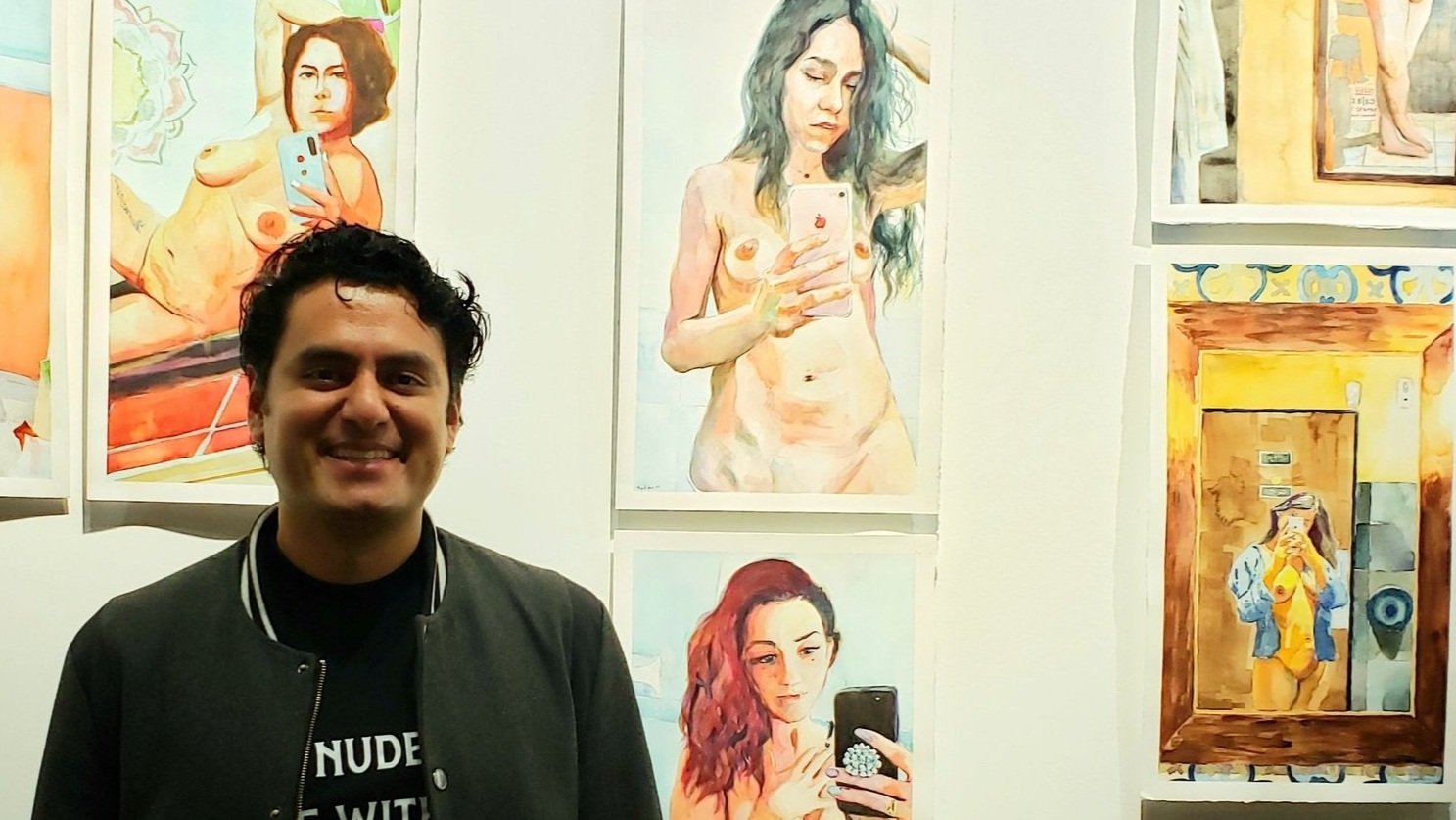Review: Miguel Casco’s ‘Send Nudes’ at Tube Factory artspace
Miguel Casco’s series of watercolors Send Nudes, on display through Nov. 28 at Tube Factory artspace, is based on selfies sent to him electronically by adult respondents.
The artist’s open call for selfies requires that participants must capture the image of their naked bodies “preferably through a mirror in which their body and mobile phone or camera will be reflected.” This exhibition involves and invites reflection in every sense of the word.
I found Casco’s portraiture, based on the respondents’ photos, to be loose and expressive. He paints quickly. He holds a painterly mirror up to his subjects. Some seem to be flirting with the camera while others are more straightforward in their poses. The majority of them seem young, in their 20s or early 30s; male, female, and perhaps nonbinary as well.
The project started, according to the Mexico City-based artist, when he and the woman who was to become his wife endured a period of separation.
“At that time she was my girlfriend,” he told me. ”She was in Italy and I was in Mexico City. So we had this distance between us. Not only the distance, but the time difference, right? I wanted to explore the intimacy through the digital mobile device ... She didn't like to send her pictures. But I was like, I don't have any trouble with my nudity … So I wanted to figure out if there were some more people who don't have trouble with nudity. So I created an open call so people could apply or submit the images. And I think I’ve had to deal with my own perception of my body because I know, at least with me, I used to think that I don't have the body that I want.”
But Casco didn’t require, in his call, that his respondents have a particular kind of body.
“It's very funny,” he said. “When I asked them to apply to the project, they say, ‘Oh no, I don't have a perfect body.’”
Maybe that’s the significance of the placement of a full-length mirror in the exhibition. Perhaps, in looking at it, patrons will take become more comfortable with their own imperfections, take pictures of themselves (presumably with their clothes on), and picture how their own portraits might look on the wall among other portraits of imperfect bodies.
Miguel Casco with some of his “Send Nudes” portraits
There is elaborate wall text in the exhibition space, where one of Casco’s curators, María José Gónzalez Camarena, elaborates on some of the complications and dangers for anyone wanting to send nude selfies electronically to, say, their loved ones. “If you don’t block your phone, I don’t know what fantasyland you’re living in, but I suggest you always do it,” she writes. “Nowadays, even beyond nudes, we might have a lot of information we wouldn’t want someone else to have access to.”
True enough. But in reading the text I found no mention of an even more important point; that it’s illegal for minors to send nude images electronically under federal and state law. Much harsher penalties can result when, say, the sender of the image is under 18 and the receiver is older.
This is a glaring omission, I think, because the exhibition doesn’t restrict access to either children or teenagers. While I suppose it’s unlikely that a teenager will be inspired by this exhibition to send nude photos to friends—to sext—it occurred to me as I wrote this article that an ounce of prevention could be worth a ton of cure in this regard.
(Fortunately, in his call for artists on his website, Casco mentions that those sending him their photos need to be 18 years old.)
As I was reading the wall text, two young boys walked into the exhibition space, followed in short order by a man who appeared to be their father. At one point the older child pointed to one of the portraits and said, “That woman’s naked.” The man calmly explained to the child that there was nothing wrong or unnatural about nudity.
I agree. But I also think that it’s hard to disentangle a discussion about the naturalness of nudity and about body-positivity from, say, the other currents in this exhibition involving shared intimacies and eroticism. Which is why this exhibit (or such an exhibit) wouldn’t be my first choice to take a young child.
In his book The Body: Photographs of the Human Form, William Ewing writes
Is there such a thing as an erotic image or is eroticism purely a function of the gaze? We know that individuals respond differently to sexually explicit material and that all kinds of factors, apart from sexual orientation, influence their response—age, experience, libido, moral values, even fashions and diverse cultural forces. What one person sees as sensuous and beautiful, the next sees as prurient and obscene.
What applies to photographs, I think, applies to these watercolors as well. The sender might be inspired to send an image by the notion of body positivity, or of shared intimacy. But the end result, when transformed by the alchemy of Casco’s watercolor, might be perceived as erotic by the viewer.
Casco tends to soften anatomical details and amp up the essences. What draws my attention are these essences. In one portrait, of a man in front of a steamed-over mirror, almost all anatomical detail is obscured. I was struck by another portrait of a woman staring at her smartphone—her face reflected in her mirror— as she brushes her hair back. It’s the intimate moment she’s sharing that I find erotic, more than her exposed flesh.
But in some other portraits, where you see men with erections, the essences seem less in the forefront.
In this exhibition that creates dialogues between essences and the concrete, between intimacy and arousal, and between paint and digital photography—through the rabbit hole of the internet—where will your gaze take you?

